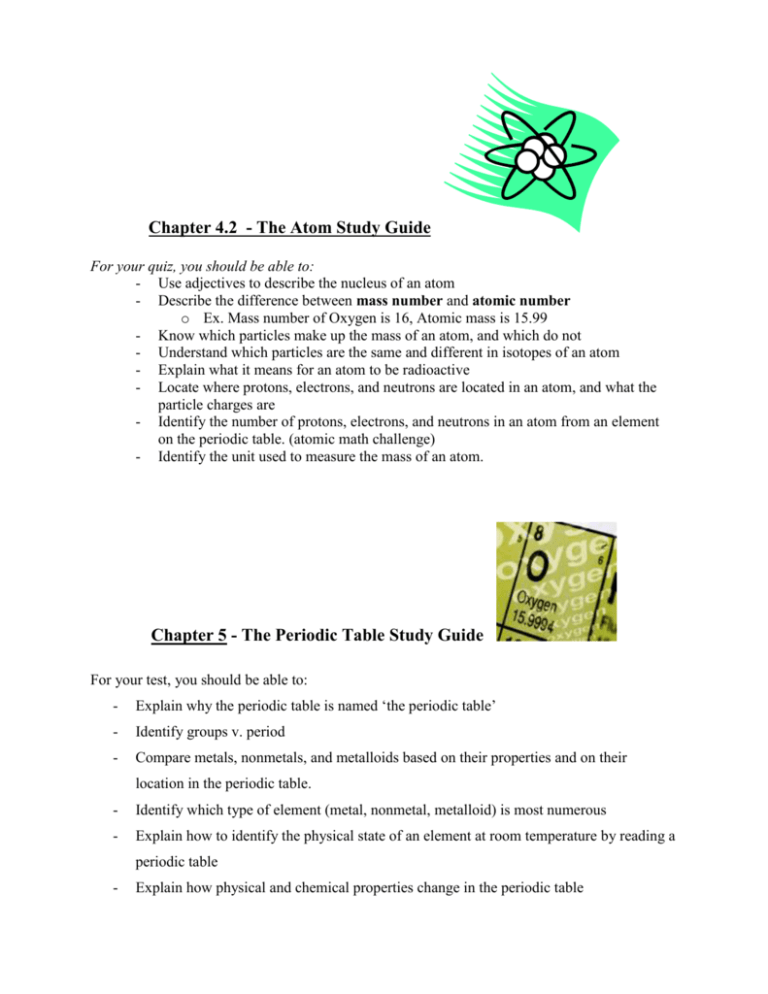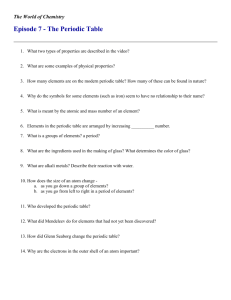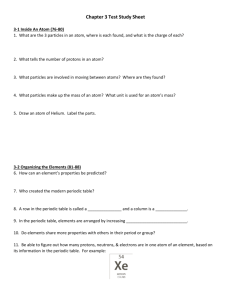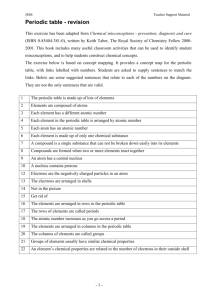Scientific Method Study Guide
advertisement

Chapter 4.2 - The Atom Study Guide For your quiz, you should be able to: - Use adjectives to describe the nucleus of an atom - Describe the difference between mass number and atomic number o Ex. Mass number of Oxygen is 16, Atomic mass is 15.99 - Know which particles make up the mass of an atom, and which do not - Understand which particles are the same and different in isotopes of an atom - Explain what it means for an atom to be radioactive - Locate where protons, electrons, and neutrons are located in an atom, and what the particle charges are - Identify the number of protons, electrons, and neutrons in an atom from an element on the periodic table. (atomic math challenge) - Identify the unit used to measure the mass of an atom. Chapter 5 - The Periodic Table Study Guide For your test, you should be able to: - Explain why the periodic table is named ‘the periodic table’ - Identify groups v. period - Compare metals, nonmetals, and metalloids based on their properties and on their location in the periodic table. - Identify which type of element (metal, nonmetal, metalloid) is most numerous - Explain how to identify the physical state of an element at room temperature by reading a periodic table - Explain how physical and chemical properties change in the periodic table - Name the various families and describe the properties of the elements in the families of the periodic table. - Identify which gas makes up 20% of the air we breathe - Identify various forms of Carbon - Explain what is formed when a halogen reacts with a metal - Within a period, identify the elements that are most metallic or least metallic - Identify atomic number, atomic mass, group number, period number, and number of valence electrons of an element in the periodic table - Identify the number of valence electrons each group has - Explain how elements are arranged in the modern periodic table. - Identify the group, period, and classification of an element. - Identify the number of valence electrons in an atom. - Identify natural forms of Carbon - Identify very reactive metals/nonmetals (Which groups are they in?) - Identify common uses of elements in each of the families - Explain how elements are named and what they are often named after - Define the following terms: atomic number, atomic mass, chemical symbol, group, period, metal, nonmetal, metalloid, periodic, periodic law, Dmitri Mendeleev, semiconductor, malleable, ductile, family, Alkali metals, Alkaline-earth metals, transition metals, lanthanides, actinides, Boron group, Carbon group, Nitrogen group, Oxygen group, Halogens, Noble gases, salt, and valence electron *This quiz will cover Chapter 5 in your CHEMISTRY textbook. To study, please use this study guide as you read the text, and the directed reading to reinforce the concepts. 5.1 SECTION SUMMARY Read the following section summary • Mendeleev developed the first periodic table by listing the elements in order of increasing atomic mass. He used his table to predict that elements with certain properties would be discovered later. • Properties of elements repeat in a regular, or periodic, pattern. • Moseley rearranged the elements in order of increasing atomic number. • The periodic law states that the repeating chemical and physical properties of elements relate to and depend on elements’ atomic numbers. • Elements in the periodic table are classified as metals, nonmetals, and metalloids. • Each element has a chemical symbol. • A horizontal row of elements is called a period. • Physical and chemical properties of elements change across each period. • A vertical column of elements is called a group or family. • Elements in a group usually have similar properties. 5.2 SECTION SUMMARY Read the following section summary. • Alkali metals (Group 1) are the most reactive metals. Atoms of the alkali metals have one electron in their outer level. • Alkaline-earth metals (Group 2) are less reactive than the alkali metals are. Atoms of the alkaline-earth metals have two electrons in their outer level. • Transition metals (Groups 3–12) include most of the well-known metals and the lanthanides and actinides. • Halogens (Group 17) are very reactive nonmetals. Atoms of the halogens have seven electrons in their outer level. • Noble gases (Group 18) are unreactive nonmetals. Atoms of the noble gases have a full set of electrons in their outer level. • Hydrogen is in a group by itself. Its properties do not match the properties of any one group.







